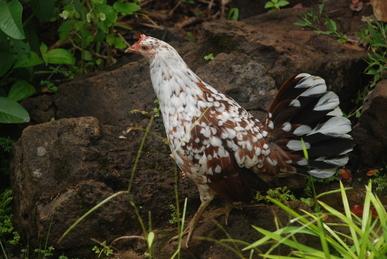Background & Aims
Background

Domesticated animals play a crucial role in everyday life, not only in the food industry, but also as pets and entertainment. The changes in morphology, physiology, genetics and behaviour that we see in domesticated animals have been important for our understanding of selection and adaptation in an articficial, human made setting. However, the process of feralization, in which a domesticated animal is unintentionally released again to the wild can reveal important information on how adaptation works in a natural setting.
The feral chickens on Kauai, Hawaii form a unique model of feralization. Domesticated chickens on the island escaped at the end of the 1980's due to two tropical storms, and have been roaming around the island ever since. Moreover, they interbred with the small native population of Red Junglefowl that were brought in by the Polynesians around the year 1200 1, 2, 3. The feral population we see on the island today are thus a mix of ancestral and domesticated genetic stocks offering high genotypic and phenotypic variation on which selective forces can act.
Aims
As a decrease of fear is thought to be the main trait selected for in early stages of domestication, I want to investigate fear-related behaviour in this feral chicken population. Ancestral Red Junglefowl and domesticated breeds such as the White Leghorn show different responses in numerous fear tests 4, 5. Therefore, I will use five well-known and commonly used fear tests to measure levels of fear in the feral chicken population, and compare them to domesticated White Leghorn chickens.
Moreover, I want to understand how brain composition adapted to the feral environment. Therefore, I aim to compare and constract feral and domesticated brains, looking at four main brain parts: the cerebellum, cerebral hemispheres, optic tectum and midbrain.
Responsible for this page:
Director of undergraduate studies Biology
Last updated:
05/25/20
